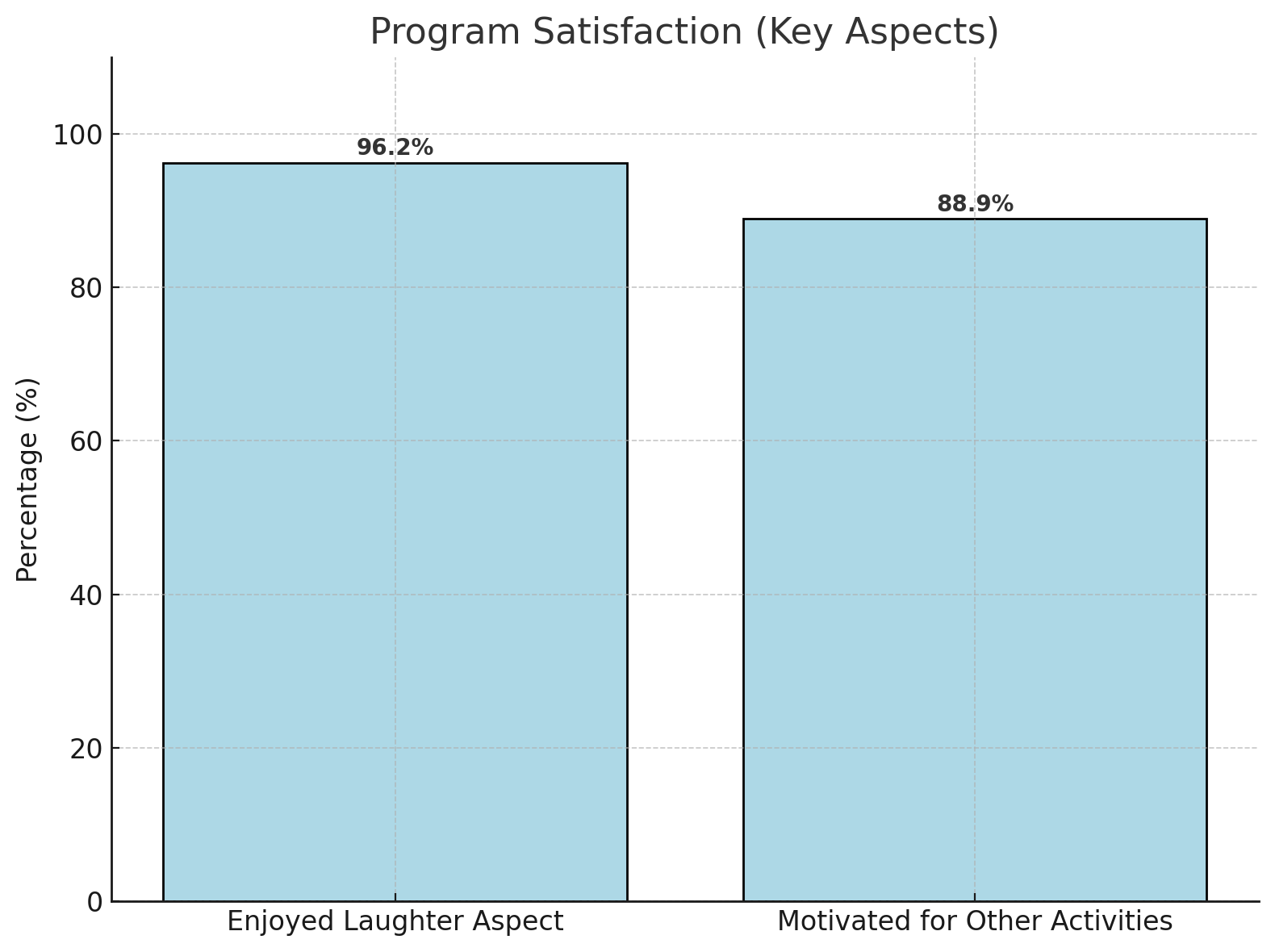
Older adults face numerous barriers to maintaining regular physical activity, including physical limitations, lack of motivation, and, crucially, lack of enjoyment. Many older adults fail to meet recommended activity levels, which can lead to negative health outcomes such as reduced mobility and independence, increased risk of chronic diseases, and poor mental health. Simulated laughter, or laughter induced intentionally through exercises, has been shown to provide many physiological and psychological benefits like improving mood, reducing stress, and stimulating cardiovascular and immune functions. This study explored whether laughter exercises could be incorporated into a physical activity program to make it more enjoyable and encourage consistent participation.
Conducted By:
Celeste M. Greene, MA (Lead researcher), Jennifer Craft Morgan, PhD, LaVona S. Traywick, PhD, Chivon A. Mingo, PhD
Institution:
The Gerontology Institute, Georgia State University, Atlanta, GA
Time and Location:
The study was conducted in 2016 and published in 2017. It was held across four assisted living facilities (ALFs), which are housing facilities for older adults, in the United States. These facilities were selected based on similar environmental factors such as cost, services, and the availability of physical activity programs.
Objective:
The study aimed to evaluate whether a combined program of simulated laughter exercises and moderate-intensity physical activity could:
- Increase participation in physical activity (PA) among older adults living in assisted living facilities.
- Improve physical health (aerobic endurance, mental health, and self-efficacy for exercise).
- Enhance self-efficacy — the confidence in one’s ability to engage in and benefit from regular physical activity.
- Make exercise more enjoyable, thereby promoting long-term adherence to PA programs.
Study Design:
Study Type: A 12-week pilot study using a wait-list control group design. This design allowed for a comparison of outcomes between the group receiving the intervention and a control group that waited before participating.
Participants: 27 older adults, mainly women (~81 years old), living in ALFs.
Intervention Program: The LaughActive program, a 6-week exercise intervention with twice-weekly 45-minute sessions. The program combined laughter exercises with strength, balance, and flexibility exercises, creating a fun and engaging way for seniors to improve physical and mental health.
Laughter Exercises: 8–10 laughter exercises integrated into the workout, where participants engage in deep breathing and laughter for 30-60 seconds during breaks between regular exercises.
Physical Activity: Strength, balance, and flexibility exercises were tailored to older adults, including seated balance exercises to reduce fall risk.
Program Protocol:
Session Format: Each session started with a warm-up (5-10 minutes), followed by 30-35 minutes of physical exercise and laughter intervals, and concluded with a cool-down and stretching (5-10 minutes).
Exercise Progression: The difficulty of exercises increased from weeks 1–3 to weeks 4–6, ensuring gradual physical progression without overwhelming participants.
Laughter and Breathing: Laughter breaks were strategically inserted between physical exercises to maintain participant engagement and create a positive emotional environment.
Session Frequency: 2 times a week for 45 minutes each session.
Outcome Measures:
Several measures were taken to assess health outcomes, self-efficacy for physical activity, and enjoyment:
Health-related Quality of Life (HRQOL): Measured using the SF-36v2 Health Survey, which assesses physical and mental health in eight domains.
Physical Performance: Measured through the Senior Fitness Test (SFT), assessing upper and lower body strength, aerobic endurance, flexibility, and balance.
Self-Efficacy for Exercise: Evaluated using the Self-Efficacy for Exercise (SEE) scale and Outcome Expectations for Exercise (OEE) scale to measure confidence in exercise participation and perceived benefits.
Enjoyment: Assessed using the Physical Activity Enjoyment Scale (PACES), which measures participants' enjoyment during physical activities.
Adherence: Tracked by attendance, noting the number of sessions attended by each participant.
Key Findings:
Improvement in Health and Fitness:
Mental Health: Significant improvements in mental health scores, including reduced anxiety and increased emotional well-being, suggesting that the laughter exercises enhanced mood and psychological health.
-
- Experimental group improved significantly (54.35 to 56.68, p = 0.056).
- Control group showed minimal change (54.00 to 54.20).

Aerobic Endurance: Significant improvement in the 2-minute step test (a measure of aerobic capacity), showing that participants' ability to sustain physical activity improved.
Experimental group improved significantly (55.66 to 64.33 steps, p = 0.036).
Control group showed slight improvement (54.00 to 54.80 steps.
Self-Efficacy:
The intervention led to a significant increase in self-efficacy for exercise (measured by the OEE scale), with participants feeling more confident about engaging in regular physical activity. Participants reported feeling more confident in managing barriers to exercise, such as pain or fatigue.
Experimental group increased confidence (4.09 to 4.35, p = 0.006).
Control group remained almost unchanged (4.00 to 4.10).

Exercise Enjoyment:
Participants overwhelmingly reported enjoying the program, with 96.2% stating that they found laughter an enjoyable addition to exercise.
88.9% found that the laughter aspect helped make exercise more accessible and motivated them to participate in other activities.

Adherence:
High levels of program adherence with 81.4% attending at least 75% of the sessions. This is consistent with adherence rates found in other older adult exercise programs.

Conclusion:
- Positive Effects on Mental and Physical Health:
- LaughActive improved mood, aerobic endurance, and confidence to exercise.
- Laughter added fun and enjoyment, making participants more likely to stick with the program.
- Feasibility for Older Adults:
- Suitable for older adults, including those with limited mobility, as exercises could be done seated.
- Effective even for people with low motivation for physical activity.
- Practical Implications:
- Combines laughter and exercise to create an accessible and low-cost intervention to improve health and well-being in older adults.
- Could be used in senior centers, nursing homes, and community health programs to boost physical and mental health while promoting independence.
